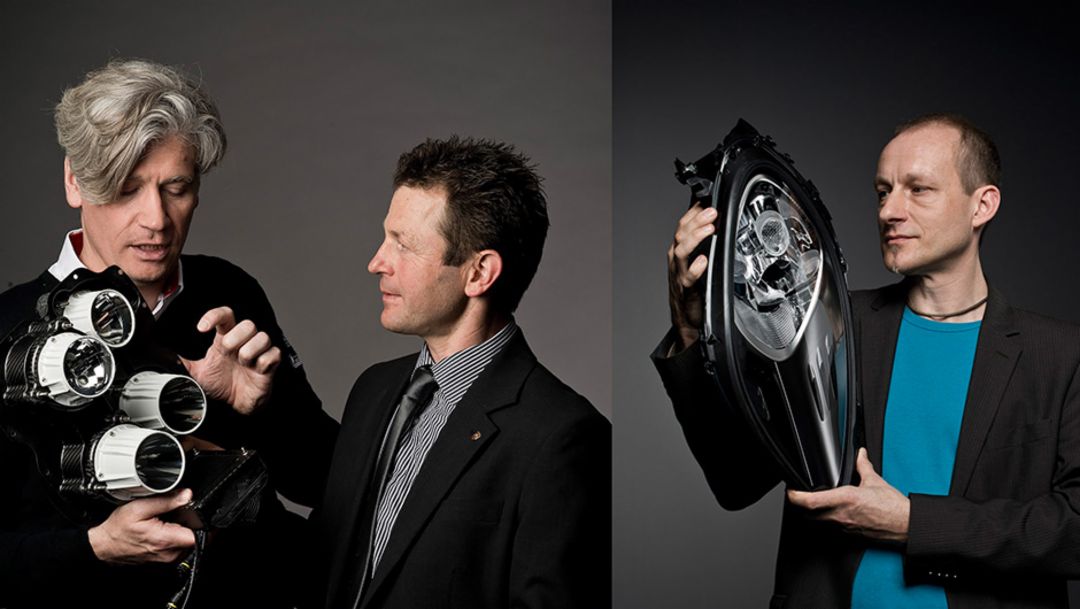Light is identity, by day as well as by night. It has attributes that also apply to Porsche sports cars: purist, unmistakable, striking. And it too follows the principle that a Porsche should be recognizable as a Porsche from afar. Since the introduction of daytime running lights, light has represented a new and fascinating challenge for Heinz Redlich, a designer at the Porsche Design Studio at the Weissach Research and Development Center. Challenges like these bring out the best in designers, because LEDs (light-emitting diodes) at Porsche have to be more than just a string of lights. “That’s not for us,” remarks Redlich, “because it’ll soon be obsolete.” A Porsche is known for its strong, enduring characteristics, especially when it comes to light.
From the idea to the perfected product, Redlich has often sat down with Peter Heimpel, who works on electrical systems development. After all, the space available for putting this ambitious project into place is not much larger than the cross-section of your average melon. A combination of specifications and inspiration led to the development of the four-point principle, which initially took up residence as a unique feature in only the top models of the different series, such as the Panamera Turbo (2009), the 911 Turbo, the Cayenne Turbo, and the Macan Turbo.
The basic philosophy is clear. “Every Porsche needs a visage, and the four-point visuals establish the brand’s identity. They clearly signal that this is a Porsche,” observes Redlich. The underlying idea with the four LED spotlights emerged during drafting: “Four points around a module are ideal. Three are harder to configure. And more would be too many.”
For reasons of efficiency—a lightbulb converts only three percent of the energy into light—it has moved from xenon lamps to LEDs, which convert 20 percent of the energy into light. Pure LED headlights shine from the 911 Turbo S, the Panamera Turbo S, and the 918. LED four-point daytime running lights are combined with xenon headlights to provide the perfect lighting from the car and onto the road.
Little high-tech jewels
Porsche’s top performers also have Porsche Dynamic Light System (PDLS) Plus, headlights that feature nearly everything: dynamic range control, adverse weather function, and a camera-based system that adjusts light distribution. The High Beam Assistant detects oncoming traffic and automatically dims the lights. The Intersection Assistant activates the left and right indicators, which broadens the cone of light and provides greater illumination of the area directly around the vehicle. In other words, PDLS stands for little high-tech jewels.
That’s not all of the artistry that has gone into these lights. The system for the Porsche 918 Spyder was also developed with an emphasis on efficiency. Because this super sports car is already designed with the greatest possible fuel efficiency, it requires the most lightweight light module from Weissach. “If a module can pivot, that means more weight,” says Redlich. So the 918 does without pivoting headlights, including the associated electronics and control units, which means its system is 1.5 kilos lighter than that in the 911. But the four-point principle is everywhere in the Spyder—including its indicator lights.
Visage on the racetrack
The headlights also help to give Porsche a unique visage on the racetrack, which is just the thing for the World Endurance Championship, with the 24 Hours of Le Mans as its highlight (pun intended). So it only makes sense that the LMP1 racing car, the 919 Hybrid, also has four-point visuals. Along with clear demands on the light itself: a lot of it, and a range of up to 800 meters. At high speeds, on dark tracks, and with slower cars on the course too, the light serves a number of safety purposes. As Martin Kaussen from the racing development department explains, “It has to shine as brightly as a searchlight from start to finish, by day and by night.” The guiding premise is to keep it simple.
Redlich is already working on designing the next generation of headlights for the standard-series models. Now that four-point visuals can be ordered as an optional feature for many series, he is considering how he can provide the top models with a different distinguishing feature. What that will be remains a secret—for now, at least. But one thing is clear for the designer. “We’re not going to throw in every technical development just because it’s currently in fashion. It’s important that every Porsche is recognizable as such from both the front and the back on account of its four-point visuals.”
Info
Text first published in the Porsche customer magazine Christophorus, No. 367.
Consumption data
Cayenne Turbo, CO₂ emissions: 270 g/km, Fuel consumption City: 15.8 l/100 km, Highway: 8.4 l/100 km, Combined: 11.5 l/100 km.
Macan Turbo, CO₂ emissions: 216–208 g/km, Fuel consumption City: 11.8–11.5 l/100 km, Highway: 7.8–7.5 l/100 km, Combined: 9.2–8.9 l/100 km.
911 Turbo/911 Turbo S (type 991), CO₂ emissions: 227 g/km, Fuel consumption City: 13.2 l/100 km, Highway: 7.7 l/100 km, Combined: 9.7 l/100 km.
Panamera Turbo/Panamera Turbo S, CO₂ emissions: 239 (242) g/km, Fuel consumption City: 14.7 (14.9) l/100 km, Highway: 7.7 (7.8) l/100 km, Combined: 10.2 (10.3) l/100 km.
918 Spyder, CO₂ emissions: 72 (70*) g/km, Fuel consumption (combined): 3.1 (3.0*) l/100 km, Electric power consumption (combined): 12.7 kWh/100 km.

